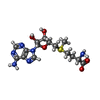+Search query
-Structure paper
| Title | Coordination of phage genome degradation versus host genome protection by a bifunctional restriction-modification enzyme visualized by CryoEM. |
|---|---|
| Journal, issue, pages | Structure, Vol. 29, Issue 6, Page 521-530.e5, Year 2021 |
| Publish date | Jun 3, 2021 |
 Authors Authors | Betty W Shen / Joel D Quispe / Yvette Luyten / Benjamin E McGough / Richard D Morgan / Barry L Stoddard /  |
| PubMed Abstract | Restriction enzymes that combine methylation and cleavage into a single assemblage and modify one DNA strand are capable of efficient adaptation toward novel targets. However, they must reliably ...Restriction enzymes that combine methylation and cleavage into a single assemblage and modify one DNA strand are capable of efficient adaptation toward novel targets. However, they must reliably cleave invasive DNA and methylate newly replicated unmodified host sites. One possible solution is to enforce a competition between slow methylation at a single unmodified host target, versus faster cleavage that requires multiple unmodified target sites in foreign DNA to be brought together in a reaction synapse. To examine this model, we have determined the catalytic behavior of a bifunctional type IIL restriction-modification enzyme and determined its structure, via cryoelectron microscopy, at several different stages of assembly and coordination with bound DNA targets. The structures demonstrate a mechanism in which an initial dimer is formed between two DNA-bound enzyme molecules, positioning the endonuclease domain from each enzyme against the other's DNA and requiring further additional DNA-bound enzyme molecules to enable cleavage. |
 External links External links |  Structure / Structure /  PubMed:33826880 / PubMed:33826880 /  PubMed Central PubMed Central |
| Methods | EM (single particle) |
| Resolution | 2.86 - 3.25 Å |
| Structure data | EMDB-23461, PDB-7lo5: EMDB-23543, PDB-7lvv: |
| Chemicals |  ChemComp-SAM:  ChemComp-CA: |
| Source |
|
 Keywords Keywords | HYDROLASE/DNA / inhibitor / Complex / endonuclease / methyl transferase / TypeIIL RM system / HYDROLASE / HYDROLASE-DNA complex |
 Movie
Movie Controller
Controller Structure viewers
Structure viewers About Yorodumi Papers
About Yorodumi Papers







 Deinococcus wulumuqiensis 479 (bacteria)
Deinococcus wulumuqiensis 479 (bacteria)